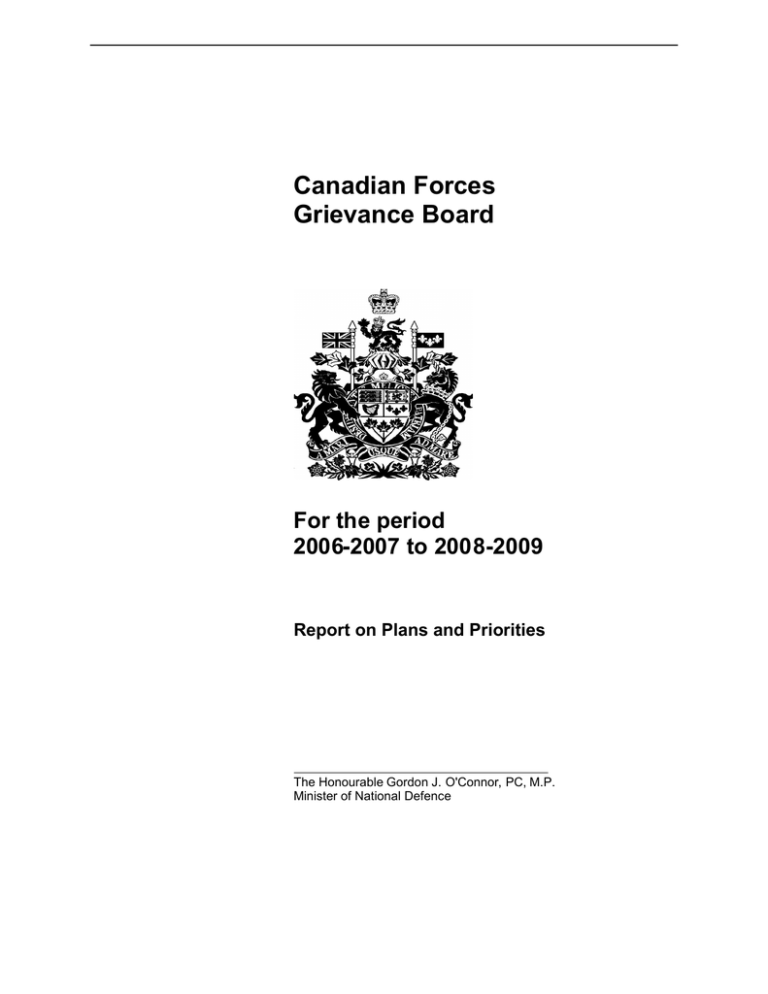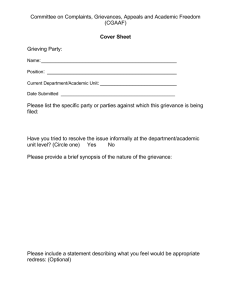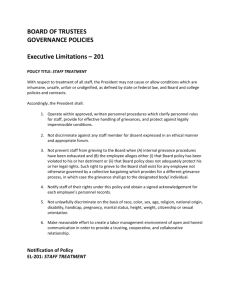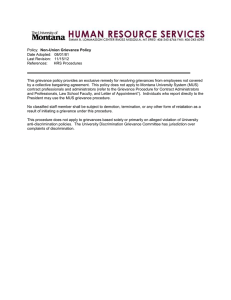Canadian Forces Grievance Board For the period 2006-2007 to 2008-2009
advertisement

Canadian Forces Grievance Board For the period 2006-2007 to 2008-2009 Report on Plans and Priorities The Honourable Gordon J. O'Connor, PC, M.P. Minister of National Defence Table of Contents SECTION I – OVERVIEW...........................................................................................................1 Chairperson’s Message........................................................................................................................ 2 Management Representation Statement ............................................................................................. 3 Summary Information ........................................................................................................................... 4 Departmental Priorities by Strategic Outcome ..................................................................................... 6 Departmental Plans and Priorities........................................................................................................ 7 Major Factors Influencing the Board .................................................................................................... 7 SECTION II – ANALYSIS OF PROGRAM ACTIVITIES BY STRATEGIC OUTCOME .............10 Analysis by Program Activity.............................................................................................................. 11 Strategic Outcome:.............................................................................................................................11 Expected Results................................................................................................................................ 12 Performance Measurement Strategy ................................................................................................. 13 SECTION III – SUPPLEMENTARY INFORMATION ................................................................15 Organizational Information ................................................................................................................. 16 Table 1: Departmental Planned Spending and Full Time Equivalents............................................... 17 Table 2: Program by Activity .............................................................................................................. 18 Table 3: Voted and Statutory Items listed in Main Estimates.............................................................18 Table 4: Services Received Without Charge ..................................................................................... 19 SECTION I – OVERVIEW 2006-2007 Report on Plans and Priorities 1 Chairperson’s Message As Chairperson for the Canadian Forces Grievance Board, I hereby present the Report on Plans and Priorities for the Canadian Forces Grievance Board, for the period 2006-2007 to 2008-2009. As an independent, quasi-judicial body, the Board is accountable to Parliament through the Minister of National Defence for administrative purposes only. Over the last five years, the Board has made significant progress in various areas of its operations, notably: the creation of a solid and working infrastructure, evolving knowledge and proficiency, and technological improvements to our case management system and website. All of these targeted improvements not only go a long way towards improving our processes, they will enhance our internal and external communications as well. Armed with experience, we also thought it time to reflect on the strengths and weaknesses of the Canadian Forces grievance system as a whole and how the Board could help improve its efficiency and transparency. I know we can do more to support Parliament’s intention behind creating the Board by ensuring the new grievance review process remains impartial, transparent and fair. In addition, the Board must ensure the continuity and renewal of its highly specialized workforce. Sufficient time must be provided for new Board Members and staff to develop the required experience and competencies. The Board will also continue to improve its management practices, placing its focus on staffing and the implementation of the Public Service Modernization Act (PSMA). I consider the Board to be a pro-active organization, not inclined to rest on its laurels but rather focussed on the challenges that lie ahead. Our original vision still has objectives to be met, but we carry with us the confidence that they will be. Diane Laurin Chairperson 2 2006-2007 Report on Plans and Priorities Management Representation Statement I submit for tabling in Parliament, the 2006-07 to 2008-2009 Report on Plans and Priorities (RPP) for the Canadian Forces Grievance Board. This document has been prepared based on the reporting principles contained in the Guide for the preparation of Part III of the 2006-07 Estimates: Reports on Plans and Priorities and Departmental Performance Reports: It adheres to the specific reporting requirements outlined in the TBS guidance; It is based on the department’s approved accountability structure as reflected in its MRRS; It presents consistent, comprehensive, balanced and reliable information; It provides a basis of accountability for the results achieved with the resources and authorities entrusted to it; and It reports finances based on approved planned spending numbers from the Treasury Board Secretariat in the RPP. Name: Diane Laurin Title: Chairperson 2006-2007 Report on Plans and Priorities 3 Summary Information The Board’s Raison d’être – The Board officially began operations on June 15, 2000, when it received its regulatory authority. It is external to and independent of the Canadian Forces (CF) and the Department of National Defence (DND), with the statutory mandate to review military grievances and to submit findings and recommendations to the Chief of the Defence Staff (CDS). The CFGB’s mandate is to issue fair, impartial, transparent and expeditious findings and recommendations on grievances from members of the Canadian Forces, in accordance with the National Defence Act (NDA) and referred to under Chapter 7.12 of the Queen’s Regulations and Orders for the Canadian Forces (QR&O). The CFGB is mandated to review grievances pertaining to: deductions from pay and allowances; reversion to a lower rank or release from the Forces; the application or interpretation of policies relating to the expression of personal opinions, political activities, and candidature for office, civil employment, conflict of interest and post-employment compliance measures, harassment or racist conduct; pay, allowances and other financial benefits; the entitlement to medical care and dental treatment; and The Chief of the Defence Staff shall refer every grievance concerning a decision or an act of the Chief of the Defence Staff in respect of a particular officer or non-commissioned member to the Grievance Board for its findings and recommendations. The CDS also has the discretionary power to refer any other type of grievance to the Board for review. A Unique Role Mission To review grievances, in order to render fair and impartial findings and recommendations in a timely and informal manner to the Chief of the Defence Staff and the grievor. Vision The Board’s grievance review skills and expertise will be recognized through the quality of its findings and recommendations. This will be realized when: The principles of integrity and fairness guiding the Board create a climate of confidence in members of the Canadian Forces; Members of the Canadian Forces are confident that the Board’s findings and recommendations are objective, timely, fair and impartial; The work of the Board has a positive impact on the conditions of work for military personnel and contributes to a better understanding and application of regulations, policies, and guidelines; The Board is the first and only civilian body in the Other public agencies, in Canada and world that reviews military grievances. In its role as abroad, consult the Board regarding their an administrative tribunal, it conducts objective, own grievance management and review transparent and independent reviews of grievances, processes. with due respect to fairness and equity for each member of the Canadian Forces (CF), regardless of rank or position. It ensures that the rights of military personnel are considered fairly throughout the process. Ultimately, it is part of the Board’s long-term objective to contribute to the improved working conditions for CF members to have a positive effect on morale, and to instil confidence in the effectiveness and fairness of the improved grievance process. 4 2006-2007 Report on Plans and Priorities The Board is a civilian administrative tribunal with quasi-judicial powers. To fully examine all information that could be relevant to a grievance, if it appears necessary, the Board can conduct hearings, summon civilian or military witnesses, and compel them to give oral or written evidence. The Board reports its findings and recommendations to both the CDS and the grievor. Its recommendations may deal not only with the grievance itself, but with potential systemic changes that could alleviate a problem or issue Forces-wide. Financial Resources (in ’000$) 2006-2007 2007-2008 2008-2009 $6,407,000 $6,407,000 $6,407,000 2006-2007 2007-2008 2008-2009 46 46 46 Human Resources * * Includes Board Members appointed by Governor in Council. 2006-2007 Report on Plans and Priorities 5 Departmental Priorities by Strategic Outcome Strategic Outcome: The recommendations of the Canadian Forces Grievance Board are implemented in the Canadian Forces and lead to improvements in the conditions of work. Planned Spending 2006-2007 2007-2008 2008-2009 Program Activity: Review of Canadian Forces grievances referred by the Chief of the Defence Staff. Priority #1 Operational performance Ongoing 3,685,000 3,685,000 3,685,000 Expected Results: Address efficiency and effectiveness in the service delivery to our clients: Achieve a steady state of operations with a target to complete a grievance review and issue its findings and recommendations within six months from the day that it is received at the Board; Ensure consistent high quality of analysis. Ensure sound internal management practices in accordance with the MAF and reflected in the Board’s Performance Measurement Strategy: Rigorous planning of human and financial resources’ needs. Ensure an efficient grievance review process that is cost effective. Priority #2 External communications Ongoing 410,000 410,000 410,000 Expected Results: Stakeholders recognize the value-added of the Board’s findings and recommendations. Enhance knowledge sharing and increase support from stakeholders. Participate at senior levels forums in support of a more efficient and responsive military grievance process. Disseminate information of the impact and value of the Board’s work. 6 2006-2007 Report on Plans and Priorities Departmental Plans and Priorities Major Factors Influencing the Board The external factors are as follows: At the operational level The appointments of Board Members, whether they be full or part-time by the Governor in Council. The unknown number of grievances that could be filed by members of the military in any given year. Delays at any point in the process, either before or subsequent to the CFGB having received a grievance and sending its findings and recommendations to the CDS. Continuing confusion, at large, about the different players at Department of National Defence/Canadian Forces (DND/CF) overseeing the same or similar matters on behalf of the military, such as the Director General, Canadian Forces Grievance Authority (DGCFGA), the Conflict Management Program (CMP) and the Office of the Ombudsman. Amendments to the National Defence Act. Having a judicial review by the Federal Court on a grievance or grievances that had been reviewed by the Board. At the corporate level Government-wide expenditure review. Any new funded or unfunded central agency initiatives that could emerge for example, the recent passage of Bill C-25, the Public Service Modernization Act. (as in the case of many small organizations, while delivering against its mandate the Board must also comply with various central agency initiatives and reporting requirements; these take up valuable time and consume scarce resources). The internal factors are: The vacant positions at the Board Member’s level (full-time and part-time) could affect the capacity of the Board to review grievances in a timely manner. The organization requires knowledge workers with highly developed skills and abilities, and recruiting and retaining these highly sought resources has proved to be an ongoing challenge. 2006-2007 Report on Plans and Priorities 7 Clients / Stakeholders / Partners The CDS, who makes a decision on the basis of the recommendations submitted by the Board; The grievor, who is the ultimate beneficiary of the decision rendered by the CDS; Members of the CF; Parliament (to whom the CFGB reports on an annual basis); Other organizations involved in similar matters, such as the Director General, Canadian Forces Grievance Administration, the Office of the Ombudsman, the Judge Advocate General and the office dealing with conflict management in DND; Former military members; veterans associations and families of both former and current members of the military; Department of Justice; Other quasi-judicial organizations; Central agencies in government; and Specialized media and military opinion leaders. Priority #1 Operational performance The Board has set ambitious but attainable objectives for the upcoming years. In order to realize these objectives, it must increase its productivity and efficiency to continue to deliver results. While treating its backlog cases, the Board was faced with the task of ensuring that its steadystate cases did not lag behind. Now that the Board has nearly completed the review of the backlog cases, it feels that it is better placed than ever to make a considerable contribution to the overall military grievance process. The Board will continue to assess its recruitment approaches and strategies through the development of its Human Resources Plan. The Board will maintain a strong focus on learning, for both new and existing staff. The Board will also need to align its HR practices to the requirements of the Public Service Modernization Act (PSMA ). More specifically, this will include: training managers and HR staff in the provisions of the PSMA and conducting awareness sessions for employees. The Board will strive to maintain the quality of its findings and recommendations. This means a continuing strong focus on the following aspects of the Board’s business: Plans strengthening performance through monitoring its Performance Measurement Strategy as detailed in the Expected Results section; increasing its production to reach a steady-state of operations and maintaining this by seeing that its timeline standards are met, thereby ensuring reasonable average cost per grievance; combining staff expertise through multi-disciplinary and cross-functional teams to ensure the highest level of expertise appropriate to each case; employing rigorous quality control mechanisms; ensuring ongoing process improvements and updates to rules of procedures; 8 2006-2007 Report on Plans and Priorities Priority #1 Operational performance reinforcing sound internal management; ensuring rigorous planning of human and financial resources; providing training and development opportunities for employees; and knowledge sharing with stakeholders/partners in the military grievance process. Risks Credibility and relevance vis-à-vis members of the Canadian Forces; Failure to demonstrate the value-added of the Board’s work. Priority 2 External communications External communications continues to be a priority for the Board. It is a required activity that helps the Board to inform its key stakeholders about its role within the CF grievance process and the progress it has made since its inception in 2000. Five years into its mandate, however, there still exists a degree of confusion concerning the roles of the different players who deal with the same or similar matters on behalf of the military. As a result, the Board strives to undertake activities such as tours of military bases, presentations to key stakeholder groups, the creation of working groups and promotion of the Board’s work via case summaries posted on its website and a new electronic newsletter. These activities will continue to be at the forefront of its external outreach strategy. Continue to improve communications through its Web site. The Board will continue to investigate initiatives relating to the strategic use of its Web site to communicate with various groups of stakeholders and the public and to ensure that stakeholders have a clear understanding of the Board’s jurisdiction. A repository of case summaries produced by the Board allows for research into past decisions on individual cases as well as cases of systemic nature. Plans Reaching out to our clients and stakeholders; Learning from and sharing information through exchanges with our clients, stakeholders and target audiences; Positioning the Board at senior level forums; Disseminating information in the impact of the Board’s work. Risks Meet expectations and sustain credibility; Failure to demonstrate the value-added of the Board’s work. 2006-2007 Report on Plans and Priorities 9 SECTION II – ANALYSIS OF PROGRAM ACTIVITIES BY STRATEGIC OUTCOME 10 2006-2007 Report on Plans and Priorities Analysis by Program Activity Strategic Outcome: The recommendations of the Canadian Forces Grievances Board are implemented in the Canadian Forces and lead to improvements in the conditions of work. Program Activity: Review of Canadian Forces grievances referred by the Chief of the Defence Staff. Alignment of program activity and strategic outcomes to Government of Canada outcomes: Federal Organizations that support all Government of Canada outcomes Financial Resources: (in ’000$) 2006-2007 2007-2008 2008-2009 $3,344 $3,344 $3,344 2006-2007 2007-2008 2008-2009 28 28 28 Human Resources: Note: The contribution of Corporate Services to this Program Activity is $3,063 and 18 FTE. The Board conducts objective and transparent reviews of grievances with due respect to fairness and equity for each member of the CF, regardless of rank or position. It ensures that the rights of military personnel are considered fairly throughout the process and that its Board Members act in the best interest of the parties concerned. The findings and recommendations it issues are not only based in law but form precedents that may facilitate change within the CF. Administrative tribunals, such as the Board, provide a mechanism outside the courts for the expeditious resolution of complex and particular matters. Acting independently of the government, tribunals have the power to make decisions through enabling statutes of Parliament. Such powers permit the tribunal to determine the existence and scope of rights and obligations in a particular field of expertise. These powers are to be exercised in accordance with the public interest and the specific circumstances prevailing in the tribunal’s area of activity. As an administrative tribunal designed to review grievances, the Board must ensure that its recommendations comply with the law and can be implemented in accordance with its enabling legislation, relevant human rights legislation and the Canadian Charter of Rights and Freedoms. Canadian courts have also rendered several decisions on a wide range of subjects and Board Members must keep abreast of these, as well as the current Queen’s Regulations and Orders for the Canadian Forces (QR&O), the Canadian Forces Administrative Orders (CFAO) and Treasury Board policies, all of which are used in the course of analyzing grievances and developing findings and recommendations. 2006-2007 Report on Plans and Priorities 11 Expected Results The Board’s Results Chain or Logic Model demonstrates how each of the items contributes to the fulfillment of the Board’s mission and the achievement of its ultimate or strategic outcome. Logic Model 12 2006-2007 Report on Plans and Priorities Performance Measurement Strategy Planned outcomes and results Performance Indicators Outputs : These are the outputs produced and the benefits to the CDS, who makes a decision on the basis of the recommendations submitted by the Board, and the grievor, who is the ultimate beneficiary of the decision rendered by the CDS. Fair, impartial and transparent findings and recommendations delivered expeditiously. 1) CFGB’s grievance operations abide by established quality standards. 2) Grievors perceive that there was impartiality and transparency and that Findings and Recommendations (F&R) are clear and understandable. 3) CFGB’s grievance process timeline standards are being met. Immediate Outcome: These are the short-term results of the Board’s activities and its output. Useful and understandable findings and recommendations that assist the CDS in rendering decisions on grievances. The grievor and the CF have had the benefit of a grievance review by an independent quasijudicial tribunal leading to the resolution of grievances. 1) CDS decisions are in support of the CFGB’s recommendations. 2) CDS finds the Board’s findings and recommendations (F&R) useful and understandable. 3) Federal Court Judicial Reviews uphold CFGB’s findings and recommendations. Intermediate Outcomes: These are the longer term results, i.e., about 5 years, that flow from its activities, outputs and immediate outcomes, and which will demonstrate progress towards achieving CFGB’s ultimate result. Precedents created by the Board, which may facilitate change. CDS decisions to address systemic issues raised by the CFGB that merit further study for possible policy or regulatory change. Better understanding and application of regulations, policies and guidelines governing the conditions of work within the CF. Reduction of grievances of the same nature. Ultimate Outcome: This is the long-term result that logically flows from the work conducted by the Board, and it is expected that it will take about 10 years before seeing substantial evidence of this result. It is to be noted that the achievement of this ultimate result may be subject to influences beyond CFGB’s work. The recommendations of the CFGB are implemented in the Canadian Forces and lead to improvements in the conditions of work. 2006-2007 Report on Plans and Priorities CFGB’s recommendations for changes to regulations, policies or procedures have been implemented by the Canadian Forces. 13 Enabling Activities: Corporate Services function includes a wide range of activities that support the Board’s outcomes. Corporate Services works for continuous improvement in the provision of timely and quality corporate administrative services, and in the promotion of sound management. Performance and Knowledge Management Ensure an integrated planning and reporting process in keeping with the Board’s Resultsbased Management and Accountability Framework (RMAF) and its Program Activity Architecture (PAA). Lead implementation of the Board’s Management Accountability Framework (MAF). Review the Board’s activities to align resources with priorities as stated in the Government of Canada’s Speech from the Throne and Budget documents. Provide information as an aid to decision-making and strategic management and, ultimately, to facilitate program improvement and organizational learning. Finance and Human Resources Management Ensure the stewardship of public funds, Expenditure Management, and Financial Management and Control. Integrate a human resources plan within the Board’s business planning and in keeping with the Board’s Staffing Management Accountability Framework (SMAF). Internal and External Communications Support open and collaborative internal communications with the support of the management team. Integrate short and long-term communications into the Board’s management framework by providing accurate, complete, objective, timely, relevant and understandable information to CFGB stakeholders about its programs and services. Ensure that the Board is visible, accessible and answerable to the clients that it serves. Continuous Learning Provision of learning plans that are in line with the Policy on Learning, Training and Development. Case Management system, databases and efficient grievance process Through the use of Web technology, ensure the availability of operational information which includes documents and correspondence associated with cases in order to analyse and improve the efficiency and cost-effectiveness of the Board with regards to its case management activities and related precedents. 14 2006-2007 Report on Plans and Priorities SECTION III – SUPPLEMENTARY INFORMATION 2006-2007 Report on Plans and Priorities 15 Organizational Information Board Members Chairperson Vice-Chairperson, Full-time Vice-Chairperson, Part-time Members Part-time The Management Team Chairperson Vice-Chairperson Operations Executive Director, Corporate Services Director, Grievance Analysis and Operations Director, Legal Services and General Counsel Functional Chiefs (4), Corporate Services The Chairperson is ultimately accountable for the work carried out by the Members of the Board. The Chairperson, the Vice-Chairperson and other Board Members are primarily supported in their work by the Director, Grievance Analysis and Operations. Grievance officers review individual grievances and seek legal input and advice when conducting their research. In addition to providing legal advice to grievance officers and Members of the Board, legal counsel led by the Director, Legal Services and General Counsel, also provide legal opinions to the Chairperson and the Vice-Chairperson on a wide range of issues. The Executive Director is responsible for providing corporate services to support the operations, including strategic business planning and performance reporting, in addition to communications, finance, administration, information technology and human resources services. 16 2006-2007 Report on Plans and Priorities Table 1: Departmental Planned Spending and Full Time Equivalents Forecast Spending 2005-2006 Planned Spending 2006-2007 Planned Spending 2007-2008 Planned Spending 2008-2009 ($ thousands) Review Canadian Forces Grievances 3,225 3,344 3,344 3,344 Corporate Services 2,985 3,063 3,063 3,063 Budgetary Main Estimates (gross) 6,210 6,407 6,407 6,407 Total Main Estimates 6,210 6,407 6,407 6,407 Adjustments: Governor General Special Warrants Collective Bargaining Procurement savings 155 (1) (10) Operating budget carryforward 100 Paylist shortfalls 110 Total Adjustments 355 0 0 0 Total Planned Spending 6,565 6,407 6,407 6,407 Total Planned Spending 6,565 6,407 6,407 6,407 228 240 240 240 6,793 6,647 6,647 6,647 46.0 46.0 46.0 46.0 Plus: Cost of services received without charge Net cost of Program Full Time Equivalents The planned spending for 2006-07 to 2008-09 reflect the Board’s currently approved annual reference level. (1) This reflects changes in planned program spending for the spending period 2005-06 as a result of the ERC planned procurement savings. 2006-2007 Report on Plans and Priorities 17 Table 2: Program by Activity ($ thousands) 2006-2007 Budgetary Program Activity Operating Total Main Estimates Adjustments (planned spending not in Main Estimates) Total Planned Spending Review Canadian Forces Grievances 3,344 3,344 3,344 Corporate Services 3,063 3,063 3,063 Total 6,407 6,407 0 6,407 Table 3: Voted and Statutory Items listed in Main Estimates ($ thousands) 2006-2007 Vote or Statutory Item Canadian Forces Grievance Board 15 Operating expenditures (S) Contributions to employee benefit plans Total for department 18 Current Main Estimates Previous Main Estimates 5,798 5,608 609 602 6,407 6,210 2006-2007 Report on Plans and Priorities Table 4: Services Received Without Charge ($ thousands) 2006-2007 Contributions covering the employer’s share of employees’ insurance premiums and expenditures paid by the Treasury Board of Canada Secretariat (excluding revolving funds). Employer’s contribution to employees’ insured benefits plans and expenditures paid by TBS 240 Total 2006-2007 Services received without charge 240 2006-2007 Report on Plans and Priorities 19


